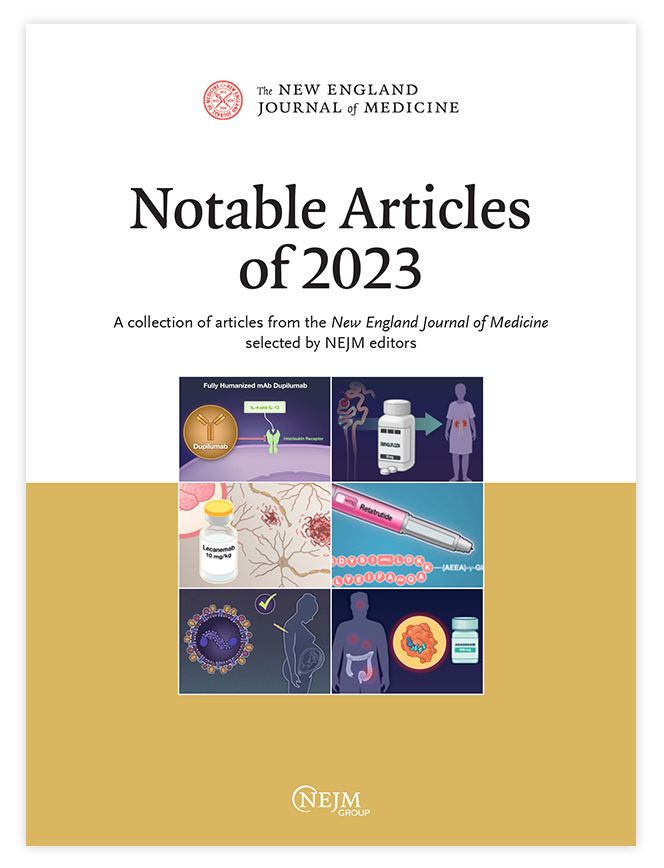口服食欲素受体2选择性激动剂Oveporexton在1型嗜睡症中的作用
IF 78.5
1区 医学
Q1 MEDICINE, GENERAL & INTERNAL
引用次数: 0
摘要
背景:1型嗜睡症是一种由食欲素神经元缺失引起的嗜睡症,导致大脑中食欲素水平低下。方法:在这项2期随机、安慰剂对照试验中,1型发作性睡病患者每天服用1次或2次overporexton (TAK-861),一种口服食欲素受体2选择性激动剂或安慰剂。主要终点是维持清醒测试(MWT)的平均睡眠潜伏期(入睡所需的时间)从基线到第8周的平均变化(范围,0至40分钟;正常,≥20)。次要终点包括从基线到第8周Epworth嗜睡量表(ESS)总分的变化(范围,0至24;正常,≤10),第8周周发作率,不良事件发生情况。结果:共90例受试者接受了超普瑞顿(0.5 mg,每日2次)治疗,23例;2毫克,每日两次,21名参与者;每天2毫克,接着5毫克,23名参与者;每天7毫克,23人),22人服用安慰剂。从基线到第8周,MWT平均睡眠潜伏期的平均变化分别为12.5分钟、23.5分钟、25.4分钟、15.0分钟和-1.2分钟(与安慰剂相比,所有比较调整后的P≤0.001)。第8周ESS总分的平均变化分别为-8.9,-13.8,-12.8,-11.3和-2.5(与安慰剂相比,所有比较的调整P≤0.004)。第8周的周发作率分别为4.24、3.14、2.48、5.89和8.76(与安慰剂组相比,每日2 mg两次和每日2 mg后5 mg组调整后P<0.05)。与过氧顿相关的最常见不良事件是失眠(48%的参与者;大多数病例在1周内缓解)、尿急(33%)和尿频(32%),无肝毒性作用。在这项涉及1型发作性睡病患者的2期试验中,在8周的时间里,过眠顿显著改善了清醒、嗜睡和猝倒的测量。(武田美洲开发中心资助;TAK-861-2001 ClinicalTrials.gov编号:NCT05687903)。本文章由计算机程序翻译,如有差异,请以英文原文为准。
Oveporexton, an Oral Orexin Receptor 2-Selective Agonist, in Narcolepsy Type 1.
BACKGROUND
Narcolepsy type 1 is a disorder of hypersomnolence caused by a loss of orexin neurons, which results in low orexin levels in the brain.
METHODS
In this phase 2, randomized, placebo-controlled trial, participants with narcolepsy type 1 received once- or twice-daily oveporexton (TAK-861), an oral orexin receptor 2-selective agonist, or placebo. The primary end point was the mean change from baseline to week 8 in average sleep latency (the time it takes to fall asleep) on the Maintenance of Wakefulness Test (MWT) (range, 0 to 40 minutes; normal, ≥20). Secondary end points included the change from baseline to week 8 in the Epworth Sleepiness Scale (ESS) total score (range, 0 to 24; normal, ≤10), the weekly cataplexy rate at week 8, and the occurrence of adverse events.
RESULTS
A total of 90 participants received oveporexton (0.5 mg twice daily, 23 participants; 2 mg twice daily, 21 participants; 2 mg followed by 5 mg daily, 23 participants; and 7 mg once daily, 23 participants), and 22 received placebo. The mean changes from baseline to week 8 in average sleep latency on the MWT were 12.5, 23.5, 25.4, 15.0, and -1.2 minutes, respectively (adjusted P≤0.001 for all comparisons vs. placebo). The mean changes in the ESS total score at week 8 were -8.9, -13.8, -12.8, -11.3, and -2.5, respectively (adjusted P≤0.004 for all comparisons vs. placebo). The weekly incidence of cataplexy at week 8 was 4.24, 3.14, 2.48, 5.89, and 8.76, respectively (adjusted P<0.05 for 2 mg twice daily and 2 mg followed by 5 mg daily vs. placebo). The most common adverse events associated with oveporexton were insomnia (in 48% of the participants; most cases resolved within 1 week), urinary urgency (in 33%), and urinary frequency (in 32%), without any hepatotoxic effects.
CONCLUSIONS
In this phase 2 trial involving participants with narcolepsy type 1, oveporexton significantly improved measures of wakefulness, sleepiness, and cataplexy over a period of 8 weeks. (Funded by Takeda Development Center Americas; TAK-861-2001 ClinicalTrials.gov number, NCT05687903.).
求助全文
通过发布文献求助,成功后即可免费获取论文全文。
去求助
来源期刊

New England Journal of Medicine
医学-医学:内科
CiteScore
145.40
自引率
0.60%
发文量
1839
审稿时长
1 months
期刊介绍:
The New England Journal of Medicine (NEJM) stands as the foremost medical journal and website worldwide. With an impressive history spanning over two centuries, NEJM boasts a consistent publication of superb, peer-reviewed research and engaging clinical content. Our primary objective revolves around delivering high-caliber information and findings at the juncture of biomedical science and clinical practice. We strive to present this knowledge in formats that are not only comprehensible but also hold practical value, effectively influencing healthcare practices and ultimately enhancing patient outcomes.
 求助内容:
求助内容: 应助结果提醒方式:
应助结果提醒方式:


